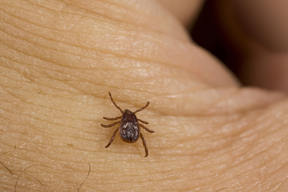Helena Sanders is used to seeing ticks. She lives in a rural area outside Fort Payne, Ala., and ticks are common. She and husband Morrison often find them on their dogs, and sometimes on themselves after a walk in the nearby woods. But in early June, Helena found one that had bitten her. Unfortunately, it proved to be among the 1 percent of ticks that carry Rocky Mountain spotted fever.
 During the following week, Helena began to have headaches and a fever. She couldn’t keep food down and began to develop a rash. During the next seven days, she made several trips to her doctor and to the local emergency department. On her third visit to the ED, doctors began to suspect Rocky Mountain spotted fever, and quickly packed her into an ambulance for the 106-mile trip to the University of Alabama at Birmingham Hospital.
During the following week, Helena began to have headaches and a fever. She couldn’t keep food down and began to develop a rash. During the next seven days, she made several trips to her doctor and to the local emergency department. On her third visit to the ED, doctors began to suspect Rocky Mountain spotted fever, and quickly packed her into an ambulance for the 106-mile trip to the University of Alabama at Birmingham Hospital.
“Her temperature reached around 103, 104 degrees”, said Morrison. “If they hadn’t gotten her to UAB, she’d be dead.”
Rocky Mountain spotted fever is rare, with less than 1,000 cases per year in the United States. It can be fatal if untreated, but it can be successfully treated with antibiotics once diagnosed.
“The diagnosis of Rocky Mountain spotted fever can be difficult, even though treatment is fairly straightforward,” said Mukesh Patel, M.D., assistant professor of infectious diseases at UAB. “Diagnosis requires complicated, lengthy laboratory tests, but we had a reasonable suspicion Mrs. Sanders had the disease and began treating her with doxycycline at once, even though we didn’t get final confirmation that she had Rocky Mountain spotted fever until nearly a week after her arrival at UAB.”
Helena arrived at UAB on June 14. Her fever spiked on Saturday the 18th, and doctors told Morrison to prepare for the worst.
“I thought I’d lost her on Saturday,” Morrison said. “A fever that high that doesn’t kill you is remarkable.”
After the antibiotics gained the upper hand and the fever finally broke, Helena was moved out of intensive care. Physicians now think she will make a full recovery although it might take another month before the rash disappears completely and she regains her strength.
The name Rocky Mountain spotted fever is something of a misnomer, as the disease is more common in the southeastern states and in Oklahoma.
“The bacteria that causes it is found in a species called the dog tick, although the number of dog ticks that actually carry the bacteria is extremely small,” said UAB Emergency Department physician David Pigott, M.D. “The tick is found across Alabama, although it is more common in Tennessee and the Carolinas.”
Pigott says ticks are most often found in forested or brushy areas, although they can pop up in just about any back yard. The best way to protect yourself is to wear long pants and long-sleeved shirts when out in the woods, and to do a careful tick check when you return home. Light colors help as ticks will show up more easily. They’ll most likely be found on ankles and legs, but also check in folds of skin, at joints and between the legs. They can also drop off branches, so Pigott says don’t forget to check the top of your head.
Patel says the best way to manage Rocky Mountain spotted fever is to not get it in the first place. He recommends using a DEET-based insect repellent when in likely tick habitat.
“Most ticks don’t carry the bacteria, so there’s little risk of getting the disease even if bitten,” he said, “but knowing what symptoms to look for can be a big help in getting quick treatment if you are infected.”
Helena Sanders says she didn’t know the symptoms of Rocky Mountain spotted fever – fever, headache, vomiting, rash – before her bout with the disease. Her advice now is don’t be shy about asking your doctor to consider Rocky Mountain spotted fever as a diagnosis if you have similar symptoms.
Helena will be cleared to go home in a day or two. She and Morrison had planned a June trip to the Gulf coast before the disease struck. “The trip is still on, although delayed until I’m well enough to go,” said Helena. “But we’re definitely going. There are no ticks at the beach.”
